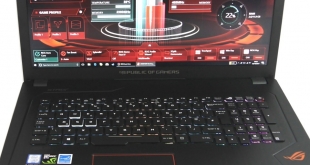
Most PC enthusiasts will be familiar with the Asus ROG name. ROG stands for Republic of Gamers, Asus’ premium brand aimed at the gaming crowd. And indeed, at first glance Asus’ ROG Strix GL753VD laptop has all the elements to do this renowned brand proud: a snazzy black-and-red design, RGB-backlit keyboard, Full HD IPS display, SSD for performance plus HDD for storage, and even the latest connectivity with USB 3.1 Type C. So far so good.
However, as any serious tech buff will be able to tell you, the single most important element in a gaming machine is its graphics card. And of course this goes double for laptops where – barring rather rare modular solutions such as Nvidia’s MXM socket or non-portable external additions like the Razer Core – the GPU is not upgradeable.
Unfortunately, though the ROG Strix GL753VD has the tagline “gaming without limits”, its relatively low-end Nvidia GTX 1050 graphics chip makes it likely that those limits will crop up rather sooner than the average gamer might like, especially in demanding titles. So can the rest of the package and its overall price still convince?
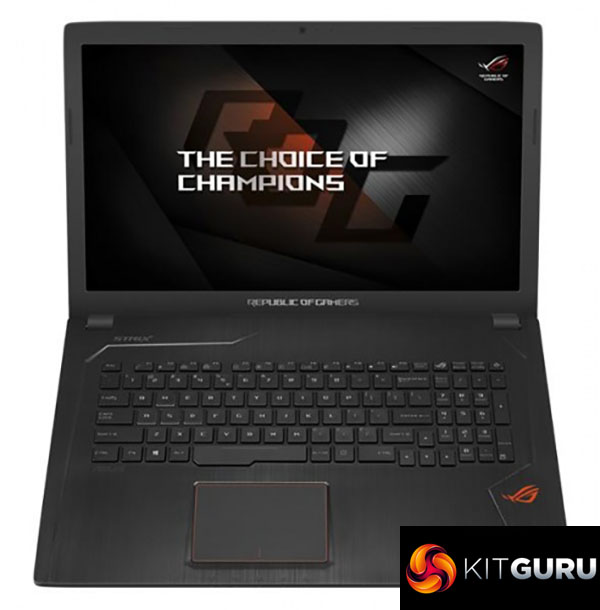
Asus ROG Strix GL753VD Specs
- OS: Windows 10 Home 64-bit
- CPU: Intel Core i5 7300HQ, 2.5-3.5GHz, 6MB cache, 45W TDP, socket 1440
- Memory: 4-12GB DDR4 (12GB in our configuration)
- Storage (main): M2 128GB SSD
Storage (secondary): 1TB 7200RPM HDD - Graphics card (integrated): Intel HD 630
Graphics card (dedicated): Nvidia GeForce GTX 1050 (GP107), 4GB GDDR5 - Display (size, resolution, Hz, Type): 17.3″ (16:9), FHD (1920×1080), 60Hz, LG IPS
- Keyboard type, design: membrane, chiclet, RGB backlit
- Connectivity (wireless)
Wi-Fi 802.11 AC
Bluetooth V4.1 - Connectivity (physical)
Audio: 1 x Microphone-in jack, 1 x Headphone-out jack
Data: 1 x USB 3.1 TYPE C port(s), 3 x USB 3.0 port(s), 2 x USB 2.0 port(s)
Network: 1 x RJ45 LAN
Video: 1x HDMI, 1 x mini DP - Optical drive: Yes, DVD (Lite-on DS-8A8SH)
- Webcam: Yes, HD
- Dimensions: 415 x 273 x 30 mm (WxDxH)
- Weight: 3kg (with battery)
- Battery: integrated 48Wh
- Warranty: 24 months (EU)
Price: £949 inc. VAT at time of review
Asus ROG Strix GL753VD Packaging & Accessories
The Asus GL753VD comes in a fairly plain box, where its most significant accessory is the slim yet rather large power brick. While it’s always nice to see a selection of bundled extras, gamers may already have many of these and, on a value-oriented product, it makes sense to keep unnecessary trimmings to a minimum.
Asus ROG Strix GL753VD Design
As befits an ROG product, there’s a distinctly ‘gamer’ vibe to the GL753VD. It has a brushed black metal lid with a subtle angular design and red LED insets flanking the ROG logo. While we appreciate that red is ROG’s signature colour, it would have been nice to be able to change the colour, especially to match the flexible RGB keyboard and any gaming peripherals you might be attaching.
Incidentally proving that PC gamer preferences (at least in the minds of gaming laptop designers) are remarkably similar, with its lid closed the ROG Strix GL753VD bears a striking resemblance to some of rival brand MSI’s portable gaming machines, such as the MSI GT80 Titan.
The GL753VD is relatively slim for a dedicated gaming laptop with optical drive, but given the modest specifications, a more Ultrabook-like profile wouldn’t have been beyond the realm of possibility – especially since Nvidia’s Max-Q initiative, as found on Asus’ own ROG GX501VI Zephyrus, looks like it may make thin and stylish gaming laptops the norm at the high end.
Opening the GL753VD up reveals a brushed metal-look interior with no metal in sight. Again subtle angles highlight the keyboard area, while a slightly recessed touchpad is demarcated in red. Though the touchpad doesn’t feature any type of lighting the keyboard more than makes up for this, as Asus’ ROG Aura Core utility allows you to light it up like a Christmas tree with an impressive variety of colours, patterns and zones – but we’ll get to that in the keyboard section.
The screen’s bezel is a lightly textured matt plastic, meaning no distracting reflections. Thankfully this bezel and the keyboard surround are fairly good at resisting fingerprints, though alas the same can’t be said for the lid or touchpad. Finally the base is also matt black plastic but livened up by bright red angular feet, which makes for a playful touch on this rarely-seen area.
Asus ROG Strix GL753VD Build
Build quality is quite decent. The plastics used generally feel solid, and though there’s some flex on the lid and on a few areas around the keyboard, it’s not accompanied by the nasty creaking that can mar cheaper chassis. Neither is opening the laptop up, which is a smooth process that can be achieved with one finger if so desired.
Not unexpectedly, the only area of minor concern is around the tray-loading optical drive, where a strong grip can meet some significant give. To be fair to Asus though, this tends to be a weak point for most laptops with optical drives in non-metal chassis.
Unscrewing the GL753VD’s bottom panel – it has 10 cross-head screws holding it together – gives access to most upgradeable components, including the optical drive, hard drive, and RAM.
Asus ROG Strix GL753VD Connectivity
Connectivity is another area where this particular Republic of Gamers laptop impresses. It offers pretty much every connection you would expect from a machine in its price class. On the left, this constitutes the power socket, RJ45 LAN jack, full size HDMI port, mini DP (DisplayPort) 1.2, two standard USB 3.0 connectors, and, in a nice touch, a USB 3.1 Type-C port.
The HDMI port appears to be version 1.4, as it does support UHD (3840 x 2160) output but only up to 30Hz. Obviously the GeForce GTX 1050 could not support 3D gaming at those kind of resolutions in anything but the most basic titles anyway, but it would be nice to have 60Hz UHD support for desktop use when hooked up to a UHD TV that does not offer DP, as most don’t. Likewise these specs will not support HDR output, though given the currently abysmal state of HDR support on PC that’s no great loss.
I would also have loved to have seen the Type-C port supporting Thunderbolt 3, so that the ROG Strix GL753VD’s graphics chips could have been beefed up with an external solution such as the aforementioned Razer Core. However, that’s not usually a realistic expectation on a value-oriented machine such as this.
On the laptop’s right side we find the remaining connections: another USB 3.0 port and a single USB 2.0 (it might have been nice if there was colour coding to indicate the difference such as making this port black instead of red, but at least the icon gives a visual indication). This is followed by the tray-loading DVD drive and Kensington lock slot.
The front houses a full-size SD card reader tucked discreetly out of the way. Thankfully this is one of those models where the card goes all the way in rather than half sticking out, which on a laptop is a potential recipe for disaster (yes we’re looking at you, Microsoft Surface Book).
Asus should also be applauded for fitting all the other connections into the side and having none at the back, which can make laptops impossible to use in tight spaces such as on buses, planes, etc. Above the screen there are array microphones and a basic webcam.
Asus ROG Strix GL753VD Power Delivery
While we wait for USB Type C and its successors to eventually standardise power delivery connectors across all mobile devices large and small, most current laptops still use clunky and non-universal chargers. The GL753VD’s 19v/6.3A power brick measures 16 x 7.5 x 2.5mm, and adds a not insignificant 400g to the laptop’s 3kg weight. It takes a standard clover-type power cable.
Asus ROG Strix GL753VD Usability – Touchpad
The touchpad on Asus’ little gaming beast is nothing to write home about but does the job fairly well. It offers a large, smooth surface that the finger can glide along without resistance, but at the same time without feeling slippery.
The lower segment of the pad is divided into left and right ‘buttons’ by a small red line, and both give positive feedback. While the pad is very responsive to single-finger input, though, multi-touch gestures are not always successful.
Asus ROG Strix GL753VD Usability – Keyboard
As already mentioned, one of the highlights of this whole gaming laptop is definitely its keyboard, thanks to that rather swank RGB backlighting. Light does not come through the keys as clearly as on some rivals, but it still spills rather attractively out of the sides and makes typing in the dark a real feast.
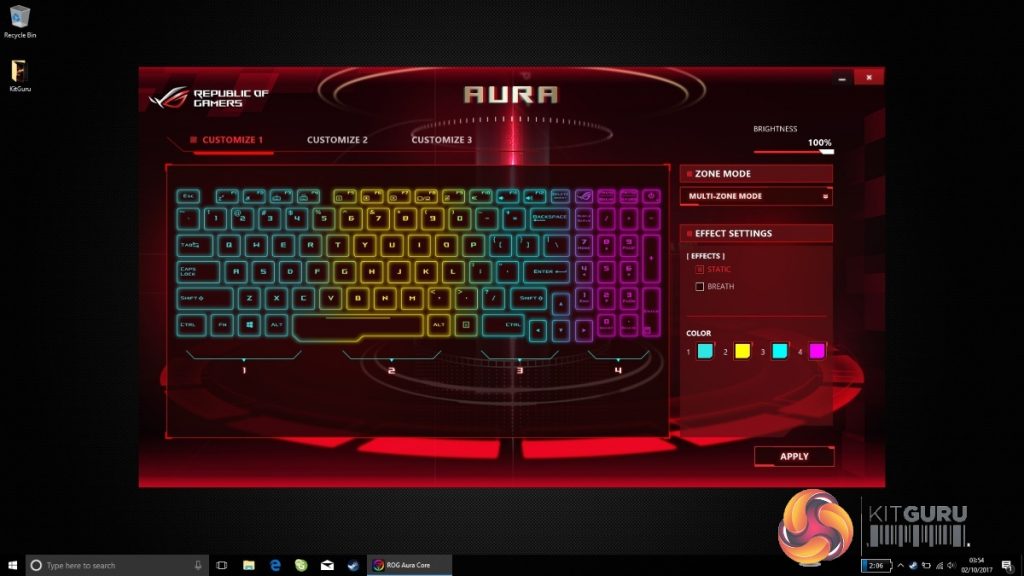
It’s also very easy to set up, thanks to Asus’ ROG Aura Core app. Here you can decide the colour of the backlighting (any colour you like), split the keyboard into four colour zones which can each have their own tint, and even add timing effects such as “breath” (which pulses the backlighting in a slow, medium or fast tempo). In a nice touch, the sides of the WASD keys are transparent, giving them that bit of extra illumination compared to their brethren.
As you would expect given the ROG Strix GL753VD’s price point, the keyboard is not mechanical; rather it’s a membrane-based chiclet affair. Key-spacing is generally good; however, we did occasionally hit the up-cursor key instead of right shift, as it doesn’t extend all the way under the Enter key – which itself is a tad on the narrow side.
While it’s nice that Asus includes a full number pad, given the space the chassis provides and ample borders to the keyboard’s sides, we wish they could have expanded it just a little to avoid any cramped layout elements.

Key feedback is on the good side of adequate with a decent amount of spring and travel. Keys are also relatively quiet, a bonus for fellow commuters on the plane or train. Last but not least it’s great to find that there’s no flex in the keyboard area while typing, giving you a consistent experience.
Asus ROG Strix GL753VD Usability – Software
On first boot the GL753VD gives quite a clean desktop experience with minimal shortcuts; yet dive into the menus and you’ll find quite a bit of pre-installed software. Some of it is minimally useful or requires a subscription to become so, like McAfee antivirus. Thankfully this was the only annoying popup and there are a few potentially handy apps, including Cyberlink’s PowerDirector 12 and PhotoDirector 5, as well as several Asus bits of which the highlights are listed below:
- Asus Install – allows you to update a meagre list of pre-installed “preferred Asus applications” like GameFirst IV for networking priority.
- Asus Live Update – can automatically update your BIOS, Drivers, and Applications.
- ROG Aura Core – lets you set up the RGB lighting on your keyboard (see keyboard section).
- Asus Splendid – on PC monitors, you can (nearly) always adjust things like the RGB values, brightness, colour temperature and the like through the OSD. Unfortunately (nearly all) laptops lack these kinds of hardware controls, and Asus’ Splendid app looks to make up for this a little by providing some basic presets and sliders.
This includes an Eye Care setting to reduce potentially harmful blue light, Normal and Vivid presets, Tru2Life video processing tech, and a Manual mode where you can adjust colour temperature. - ROG Gaming Center – perhaps the most interesting of the lot, this is the command interface for the GL753VD, and it’s considered so important there’s a dedicated keyboard shortcut to summon it. This centre gives you basic device specs, lists the realtime CPU and GPU frequencies plus temperatures, shows storage and RAM usage, and allows you to access the above apps in addition to Fan Boost and ROG Audio Wizard.
You can also disable the keyboard’s Windows key from here, which many gamers will no doubt appreciate. Not only does the ROG Gaming Center allow you to assign all these settings to three different profiles, but you can also control it from an Android device by simply scanning the centre’s on-screen QR code.
In terms of games, selected laptops with an Nvidia 1050 or 1060 graphics card (naturally including the GL753VD) currently get a free copy of the popular Rocket League football car racing battler, which should be good for hours of fun – even if you hate football and racing games.
Asus ROG Strix GL753VD Screen
It’s a measure of just how far portable displays have come in the last few years that we can call the GL753VD’s 17.3” Full HD (1920 x 1080), IPS-type panel mid-range. Naturally it’s head and shoulders above the TN-type panels found on the majority of cheap and cheerful no-brand ‘gaming’ laptops as – like VA to a lesser extent – IPS usually ensures great viewing angles and decent colours.
Obviously a 100Hz or faster display would always be preferred on a gaming laptop, but one is hardly to be expected on a machine costing under £1000. Likewise, this particular ROG’s GTX 1050 graphics card would struggle to run 3D games at anything close to those kinds of refresh rates, so when taken in context the display’s native 60Hz really isn’t a significant limitation.
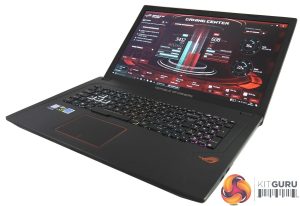
On the other hand, adaptive sync (known as G-Sync for Nvidia solutions and FreeSync on the AMD side) would definitely pay dividends in situations where the GL753VD’s GPU might struggle to maintain even performance at anything close to the display’s maximum. Unfortunately, this is still not a technology we’re seeing anywhere but at the high-end in laptops.
Given that Nvidia’s mobile implementation of G-Sync does not appear to require a proprietary and expensive chip as its monitor solution does, we can but hope adaptive sync from both the red and green teams will trickle down to mid-range and budget laptops in the near future.
In terms of measurable performance, the GL753VD’s screen performed well enough but not up to levels where we would use if for colour-critical work without serious calibration. As with all LCD-type displays, keep in mind that colour measurements can vary from panel to panel, and results depend on a variety of factors. Therefore these should be taken as a broad indication only.
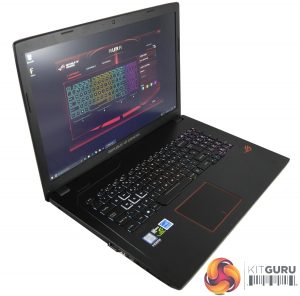
With the screen of our GL753VD set to its maximum brightness, black level was not the best at 0.35, but a relatively high luminance of 367cd/m2 (also known as nits) nonetheless gave a contrast ratio of 1044:1 – very respectable for an IPS-type panel. This means that while dark areas of games may look just a tad grey on maximum brightness, at least it would be offset by lively colours and punchy highlights.
Next we tried the same measurement as close as we could get to 120cd/m2 – thanks to the limited steps of brightness for the display’s hardware control, this was 110cd/m2 (raise brightness by three key presses from minimum to get this level). Now black level was a much better 0.11, so for predominantly dark games we would recommend lowering your screen brightness.
Measured screen uniformity was decent at 110cd/m2, with the largest luminance difference being 6% brighter than the centre. However, knocking brightness back up to maximum showed up noticeable light bleed from the bottom right corner, which significantly affected dark games and video with black bars. Again, this may vary from sample to sample, but it was certainly distracting.
Default gamma was a little off, measured at 1.95 instead of the more desirable 2.2. Similarly, at 6744K, colour temperature strayed somewhat from the 6500k ‘daylight’ ideal. Colour coverage failed to meet the standards of pricier mobile displays, with only 86.5% of sRGB covered (along with 63.3% of AdobeRGB and 72.3% of DCI P3).
Colour accuracy was quite impressive according to dE76, with an average of 0.09 and maximum deviation of only 2.19 (lower is better); unfortunately it proved less so using the more accurate dE2000, where the GL753VD achieved an average of 4.2 and dE9.3 maximum. These figures are not great, but do keep in mind that the older standard is often used when comparing to rival displays.
Asus ROG Strix GL753VD Speakers
Keeping in mind we’re talking about no-fanfare laptop speakers, the hidden models in the GL753VD give a good account of themselves. The roomy chassis allows them to disperse very nicely, providing a surprisingly broad sound stage.
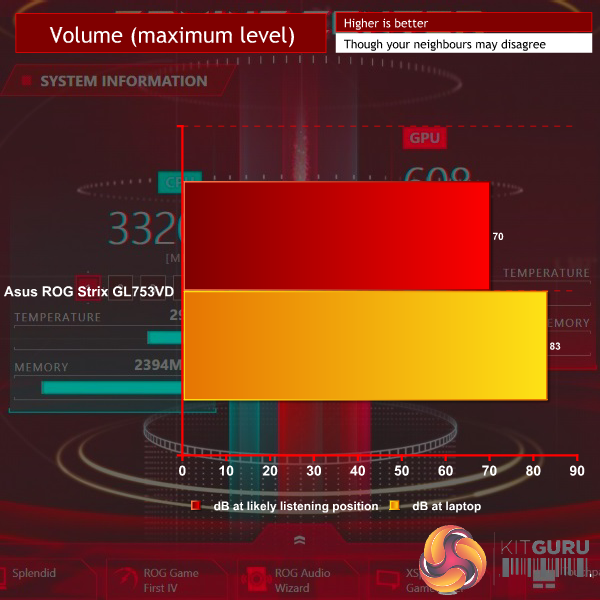
They can also manage an impressive volume level without too much distortion. We measured 83dB maximum near the laptop’s front, which as a point of reference is almost as loud as the average lawn mower. Depending on your sitting position, your ears will get around 70dB.
As usual for mobile audio efforts, these speakers’ biggest downside is a noticeable lack of bass, leaving thumping tracks sounding on the tinny side. However, they still pack a punch and we’d happily use them for YouTube and casual gaming.
Noise guide:
10dBA – Normal Breathing/Rustling Leaves
20-25dBA – Whisper
30dBA – High Quality Computer fan
40dBA – A Bubbling Brook, or a Refrigerator
50dBA – Normal Conversation
60dBA – Laughter
70dBA – Vacuum Cleaner or Hairdryer
80dBA – City Traffic or a Garbage Disposal
90dBA – Motorcycle or Lawnmower
100dBA – MP3 player at maximum output
110dBA – Orchestra
120dBA – Front row rock concert/Jet Engine
130dBA – Threshold of Pain
140dBA – Military Jet takeoff/Gunshot (close range)
160dBA – Instant Perforation of eardrum
Asus ROG Strix GL753VD Acoustic Performance
During runs of anything graphically intensive the cooling kicks into overdrive, going from whisper quiet (just over 25dB) to very audible indeed. After running Prime 95 and FurMark simultaneously for 20 minutes, we measured fan noise at just above 60dB. Mind you, the whir is constant and not particularly annoying, but if you’re after quiet gaming this is not the laptop for you.
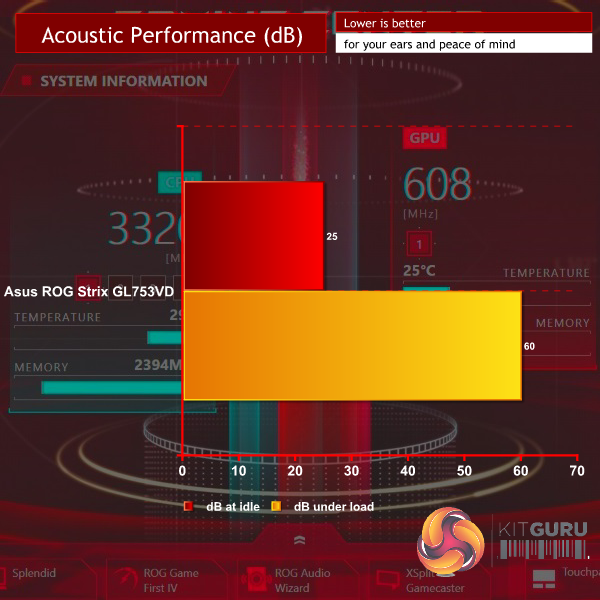
Asus ROG Strix GL753VD Thermal Performance
While running Prime 95 and FurMark simultaneously, maximum temperature for the CPU was measured at 87 °C, while the GPU reached around 80 °C; figures within thermal limits for these components.
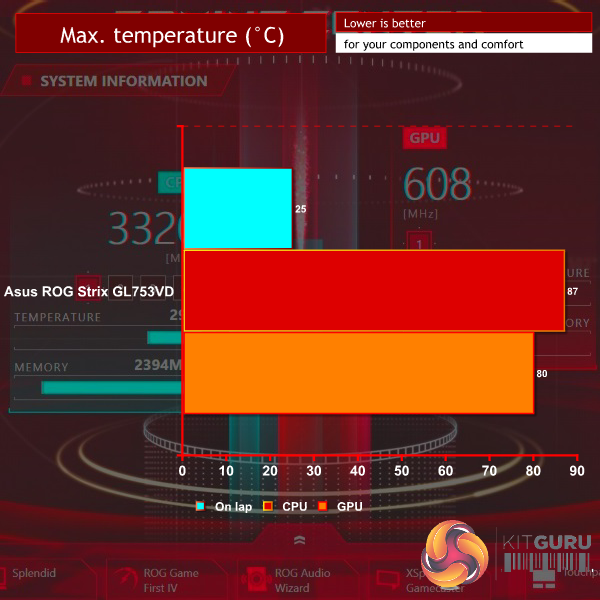
The laptop’s base remained relatively cool throughout meaning it should still be comfortable on the lap. Just be aware that the GL753VD exhausts nearly all of its hot air from a fan grill on the left side, and this not only gets very hot to the touch (over 40°C) but also aims its hot air slightly downward.
We used a laser IR thermometer to measure the main chassis’ temperature at six points on the top and bottom. Below are the results rounded to the nearest degree Celsius.
| BOTTOM | ||
| 30 | 29 | 27 |
| 32 | 30 | 27 |
| TOP | ||
| 36 | 35 | 27 |
| 28 | 28 | 26 |
Temperature guide:
<30°C – Comfortable for long periods.
<40°C – Noticeable heat but comfortable depending on other factors.
<50°C – Noticeable heat, prolonged exposure can be uncomfortable.
>50°C – Likely be uncomfortable, prolonged contact with skin may be painful.
Asus ROG Strix GL753VD Power Consumption
At idle, the GL753VD draws an average of 12-40w. Average under load was around 115W, while the maximum power draw we measured from the wall was 132W. This is with the screen at maximum brightness and GPU/CPU under full load.
Asus ROG Strix GL753VD Battery Life
Asus has provided the GL753VD with a non-removable 48Wh Simplo-branded battery, with a chargeable capacity of around 42500mWh/2840mAh. The realistic maximum you can expect to get from this configuration is generally around three hours, which was borne out by our testing.
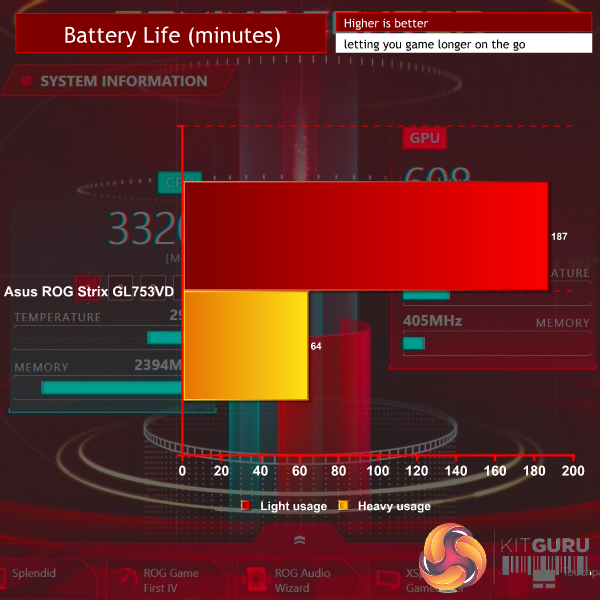
With screen brightness set to 110 nits, the battery lasted 187 minutes in the Reader test, which reflects light usage. With screen brightness at maximum and running a heavier load to simulate gaming, this Republic of Gamers machine lasted just 64 minutes, so don’t expect long gaming sessions on the go. Though to be fair, that’s a caveat which does apply to many gaming laptops.
Asus ROG Strix GL753VD Performance & Benchmarks
3DMark
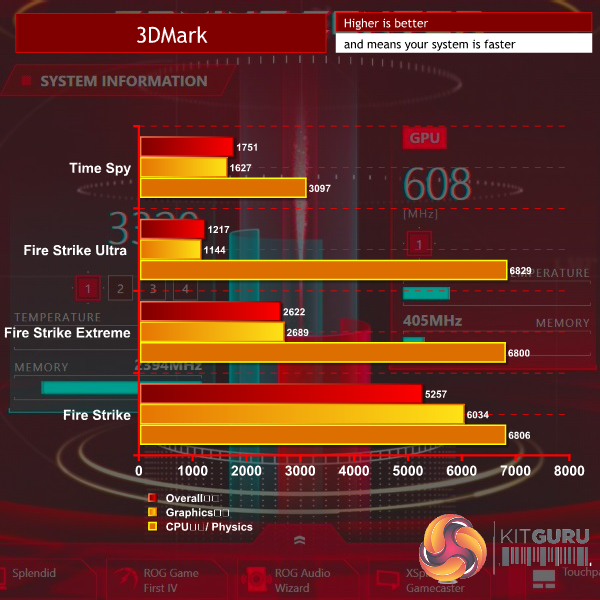
Cinebench R15
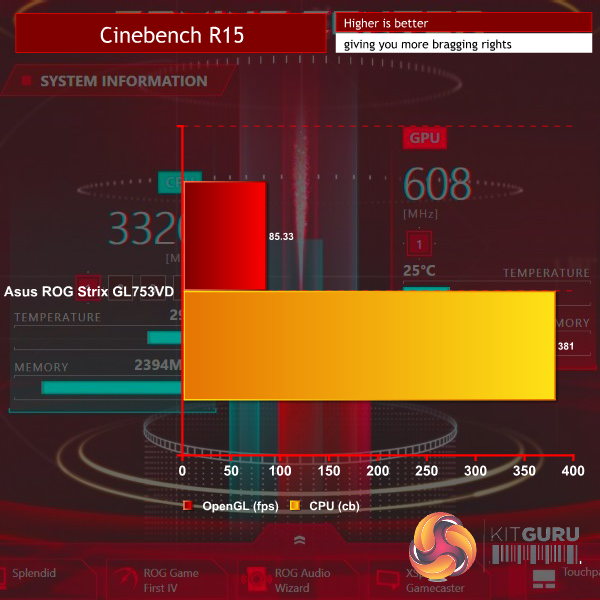
AS SSD
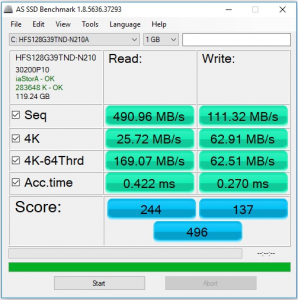
CrystalDiskMark
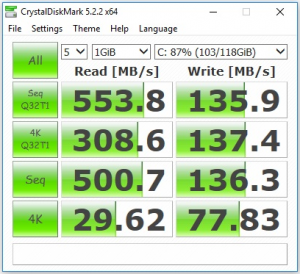
Asus ROG Strix GL753VD Gaming
Rise of the Tomb Raider
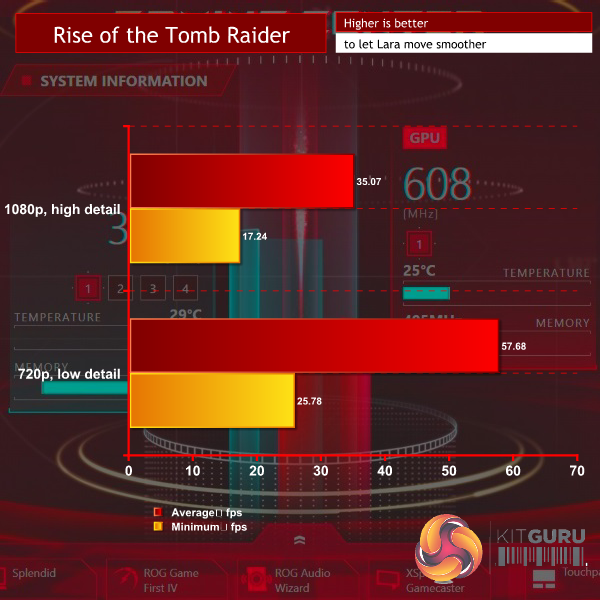
In our first gaming test, the ROG Strix GL753VD already shows the limitations of its GTX 1050 graphics. At the screen’s native resolution of 1920 x 1080 and on Rise of the Tomb Raider’s default High detail settings running in DirectX 11 mode, it barely scraped by with a 35fps average, while dipping as low as 15.21fps in the Syria section.
Even dropping detail down to low and resolution to 1280 x 720 didn’t save the performance completely, with a smooth 57.7fps average but still a low point of below 30fps – and this is at settings that make a gorgeous game look like an early PlayStation 3 title.
Deus Ex: Mankind Divided
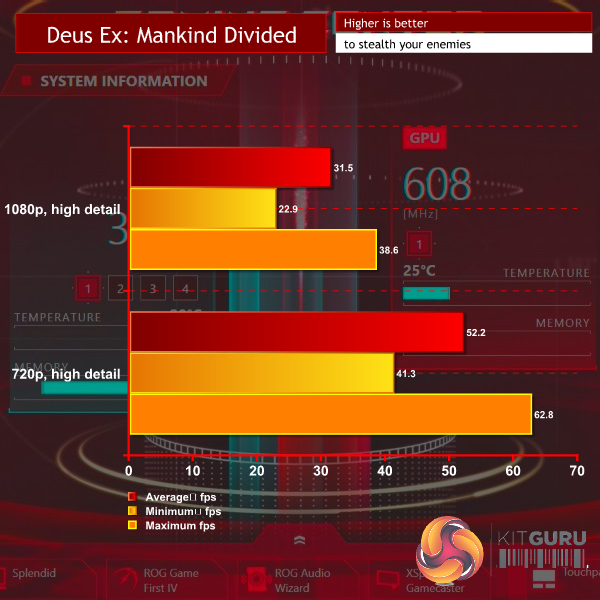
The less demanding Deus Ex: Mankind Divided fared better, but even here the GL753VD struggled at its native screen resolution, and we had to drop it down significantly to get a smooth experience.
Ashes of the Singularity
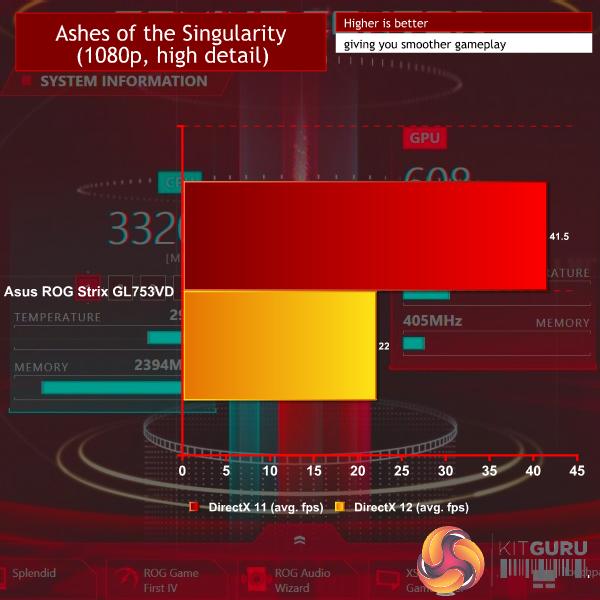
Just like Tomb Raider, Ashes drove this Republic of Gamers machine to its limit, and activating DirectX 12 slowed it to a crawl. Is there much point to a card being compatible with the latest DirectX version if it can’t actually run most titles at playable framerates?
The Asus ROG Strix GL753VD is a bit of a conundrum. It’s a well-built laptop with attractive looks (as long as you like the ‘gamer’ vibe), good connectivity, surprisingly punchy speakers, an overall reasonable IPS screen with great brightness and viewing angles, and a visually outstanding RGB keyboard that’s pretty enjoyable to use too.
Most of the specs are nicely balanced here for the price, with a quad-core Core i5 backed by 12GB of RAM and a 128GB SSD/1TB HDD combo providing a solid base for most tasks, whether they’re related to productivity or entertainment.
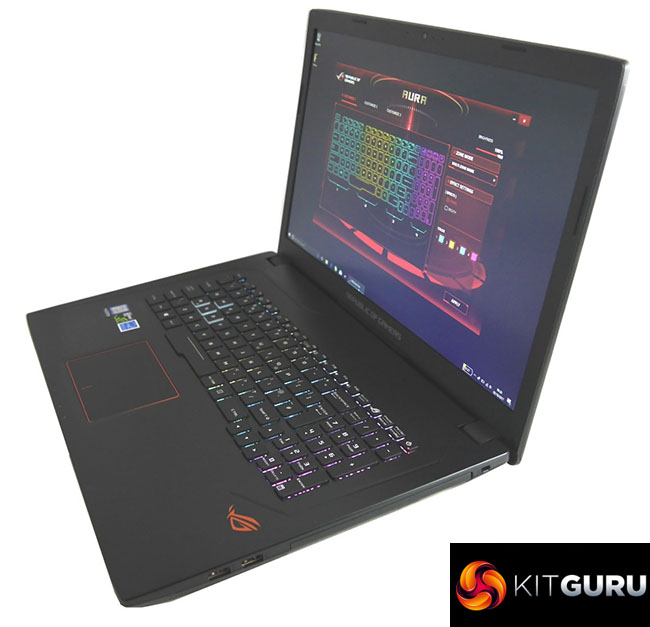
However, given the Republic Of Gamers brand and Asus’ own tagline for the Strix GL753VD as providing “gaming without limits”, the choice of an Nvidia GTX 1050 graphics card is somewhat regrettable. Unless you’re the type of gamer who limits themselves to ‘casual’ and undemanding titles like Fifa 17, World of Warcraft or Minecraft, this chip just isn’t going to give you playable frame rates at high detail settings. And that goes double when you’re trying to run games at the screen’s native 1920 x 1080 resolution.
On top of this, the GTX 1050 is not classified by Nvidia as VR Ready, so if virtual reality is something you have an interest in or might want to try later, do yourself a favour and buy a laptop with a more powerful discrete graphics card. In fact, if you’re willing to settle for a TN-type display, it’s pretty easy to find a similarly specced laptop with a GTX 1060 for only a little more money. As regular KitGuru readers will already know Nvidia's GTX 1060 is very capable at 1080p.
Incidentally, the same restrictions apply to HDR, which Asus’ GL753VD cannot fully support due to its video outputs. Mind you, given the messy state of HDR support on PC and the dearth of content that’s been properly mastered to work on it, that’s currently not a significant disadvantage.
So who is the ROG Strix GL753VD good for? Aside from serving the more casual crowd who prefer looks and brand over performance, this ROG’s combination of GTX 1050 CPU with a large and bright IPS screen does at least make for a nice productivity machine. Unfortunately, the screen is not quite accurate enough that we could recommend this laptop for any kind of colour-critical work.
Keeping in mind the average battery life and audible cooling when under load, we have to conclude that the GL753VD is a jack of all trades but master of none. Yet at the same time, if its balance of features and performance appeals despite the limitations, you are getting a decent package for the money.
The Strix GL753VD as reviewed is available from LaptopsDirect for £950 here.
Discuss on our Facebook page, over HERE.
Pros:
- Nice design.
- Visually arresting RGB-backlit keyboard.
- Pleasant typing and touchpad experience.
- Overall decent IPS screen with good viewing angles and brightness.
- Generous connectivity for its class.
Cons:
- GTX 1050 cannot run demanding games at close to native resolution.
- GTX 1050 is not VR Ready.
- Screen is not very colour accurate out of box.
- Very noticeable backlight bleed from screen in one corner.
- Average at best battery life.
KitGuru says: Its bright IPS screen and beautiful RGB keyboard rescue this ROG laptop from mediocrity. Not what we expect at all from the Republic Of Gamers brand.
 KitGuru KitGuru.net – Tech News | Hardware News | Hardware Reviews | IOS | Mobile | Gaming | Graphics Cards
KitGuru KitGuru.net – Tech News | Hardware News | Hardware Reviews | IOS | Mobile | Gaming | Graphics Cards




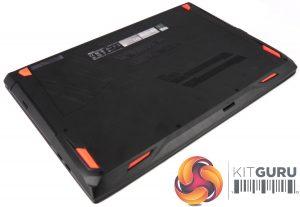
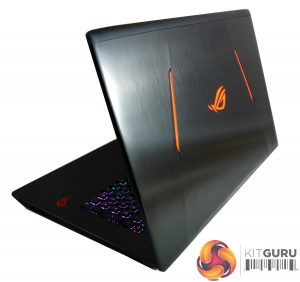



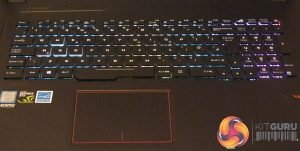
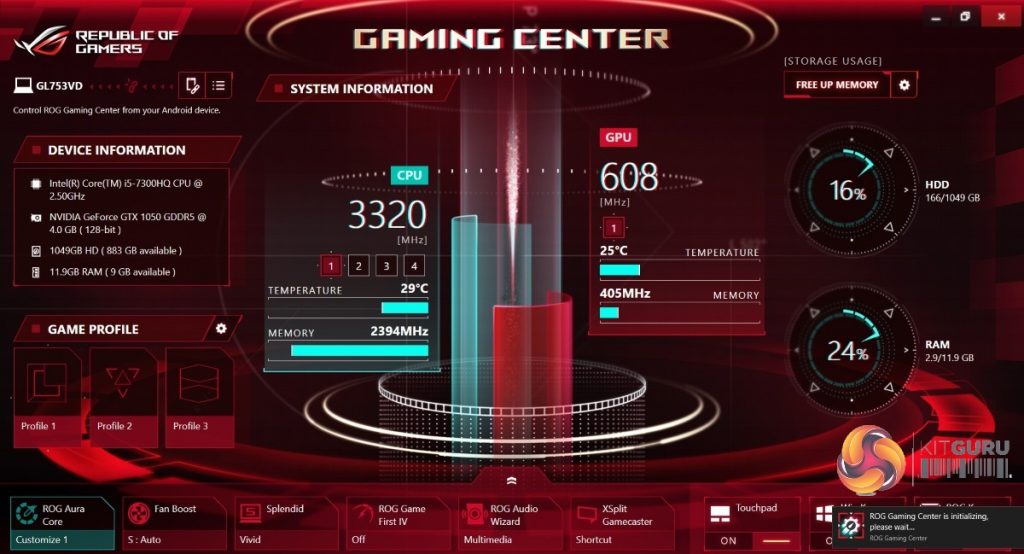
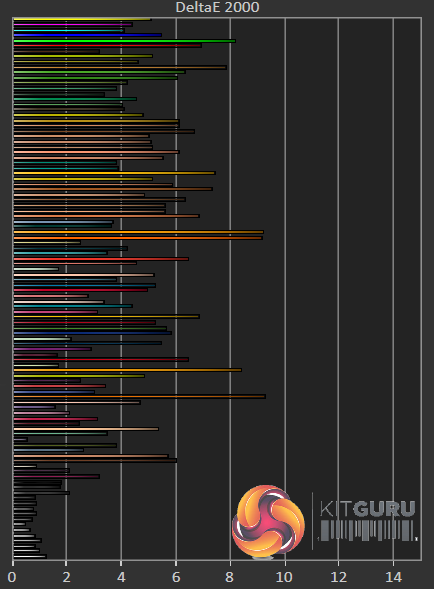

Seems more like a good laptop for content creation than a gaming laptop to me.
Not that the gaming framerate is not acceptable, but I think as well that if you say a laptop is for gaming you need something that can give a more consistent performance in modern games.
Honestly f performace, the first question with laptops should always be “Can you keep the damn thing cool, so you can use it to its potential ? ” I checked and it seems this model has only 1 fan(unless I got the wrong one, feel free to correct me). Kind of worrying in my book.
good question.